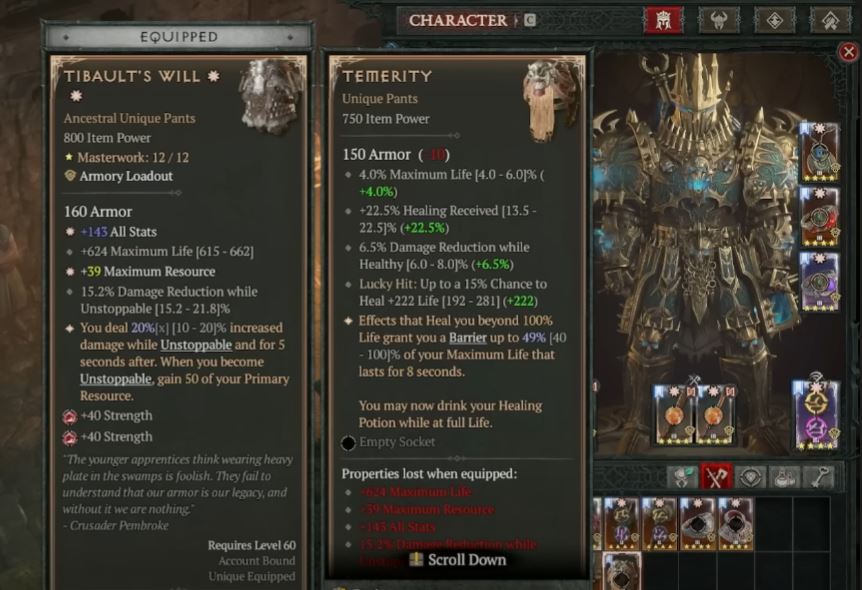This guide provides a clear breakdown of the core gearing mechanics in Diablo 4 Season 9, focusing on the fundamentals of gear types, imprinting, the Codex of Power, unique items, affixes, enchanting, and the basics of tempering and masterwork. The information below offers straightforward explanations and practical tips to help both new and returning players quickly understand how to efficiently power up their characters throughout the season.
Getting Started with Gear Types While Leveling
Gearing characters in Diablo I can be daunting, especially for new players. This overview helps set up the basics to start gearing efficiently. While leveling, several gear types appear: white (common), blue (magic), yellow (rare), orange (legendary), and tan (unique).
Affixes: White gear has 1-2 affixes, blue/yellow gear has 2-3, orange (legendary) gear always has three, and unique gear always has four.
| Gear Color | Type | Affixes |
| White | Common | 1-2 |
| Blue | Magic | 2-3 |
| Yellow | Rare | 2-3 |
| Orange | Legendary | 3 |
| Tan | Unique | 4 |
While leveling up to about 50-55, the only important thing is if a gear piece shows green stats, equip it; otherwise, leave it off and salvage everything. Whisper caches provide millions of gold, making salvaging far more valuable than selling gear.
Understanding Gear Names and Build Guides
Build guides may list the names of items, especially for legendary gear. However, the name is not crucial for imprinting. The important part is the aspect or affix. Imprinting allows the addition of aspects to gear, changing its name in the process. Therefore, focus on the aspect rather than the gear name.
Players can find endgame and leveling build guides for the barbarian and other classes on community sites and resources. These guides frequently emphasize aspects over item names, reinforcing that imprinting determines the critical properties of gear.
Imprinting and the Codex of Power
Imprinting involves taking an aspect and adding it to a piece of gear at the Occultist. Materials are required for imprinting; these are obtained throughout gameplay. Once imprinted, a piece of gear’s name and properties are updated.
The Codex of Power is accessed via the collections tab and contains all discovered aspects. Aspects are acquired from dungeons or by salvaging legendary items. Completing dungeons adds their aspect to the Codex automatically.
Salvaging legendary gear with an aspect icon upgrades the Codex, retaining the highest-level aspect ever found for future imprinting. The Codex of Power organizes aspects as Defensive, Offensive, Resource, Utility, and Mobility, each applicable to specific gear slots.
When searching for specific gear or resources, players often buy Diablo 4 gold to ease the process, especially when salvaging or imprinting frequently.
Uniques and Target Farming
Unique item names are always consistent and cannot be imprinted with aspects. Each unique comes with a specific aspect that cannot be transferred or imprinted elsewhere. Build guides will indicate required uniques for each build.
To find unique items, utilize target farming guides that list each boss and the uniques they drop, broken down by class and general pools. Mythic drops are possible from every boss but are extremely rare, often requiring 100-200 boss fights for a single drop.
Affixes and Greater Affixes
In the endgame, gear with greater affixes (starred) is most beneficial, providing 1.5 times the normal stat value. Imprinting remains essential, as it allows existing legendary gear to gain additional benefits. Pieces with greater affixes and the right imprints are highly sought after.
Enchanting Gear for Optimal Stats
Enchanting enables one affix line to be rerolled per gear piece. Select the unwanted stat, review possible new affixes, and use the enchant option to receive two new choices. Each affix has a possible value range, and the desired stat can be selected and replaced.
Every enchant increases the gold cost, starting at hundreds of thousands and capping at 2-3 million gold. This makes it easy to run out of gold when seeking perfect rolls. Monitoring gold usage is essential, particularly when pursuing rare stats.
For those seeking to optimize their characters further, acquiring specific Diablo 4 items for Season 9 can accelerate the process, especially when enchanting and imprinting are required frequently.
The enchanting process is limited to one affix line per gear piece. Once an affix is selected for rerolling, subsequent changes must be made to that same line only.
Tempering and Masterwork
Tempering and masterwork are advanced topics providing significant power increases and are covered in separate resources. Mastery of these systems is key to achieving maximum damage potential and advancing through higher Torment levels.






